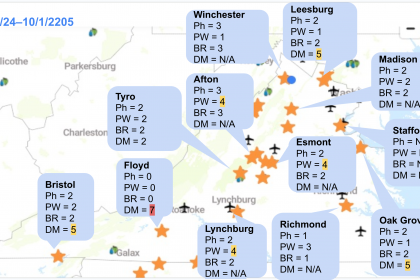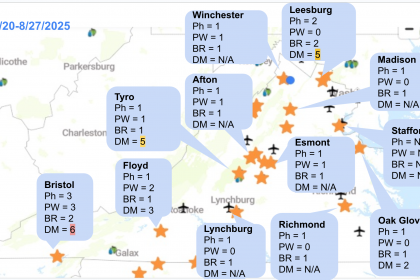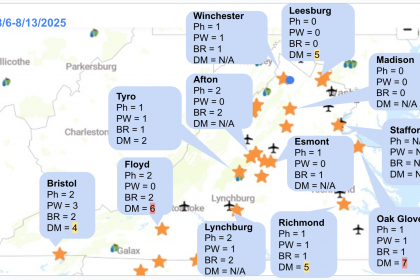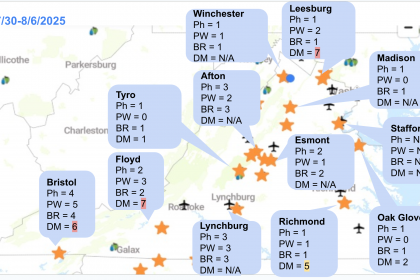If you missed the VVA, here are my handouts. Please consider joining the downy mildew model project. We don’t need a lot of people, but I would like to have enough feedback to improve our outputs and models.
Here’s a snapshot from the last week, showing the number of days with the risk of each disease: Ph = Phomopsis, PW = Powdery mildew, BR = Black rot, and DM = Downy mildew. At this point, Phomopsis and black rot risk probably won’t be as important as earlier in the season. You can ignore Phomopsis and black rot since Phomopsis should be done with their spore production, and clusters are resistant to black rot infection. This information was made available through the Wine Board-funded Sentinel Vineyard project.
The disease risk trend for the state was similar to the past four weeks. The central VA had another wet week, which resulted in many days with downy mildew risk event(s). This week, it extended to the east of the Blue Ridge Mountains. Other locations showed days with downy mildew risk, while small numbers of black rot risk days indicate warm and humid nights and short rain events.
We are through the critical period (i.e., ~6 weeks from bloom) for black rot and powdery mildew cluster infection. If your vineyards are clean at this point, you may be able to extend the spray interval from “7 to 10 days” to “10 to 14 days”, depending on the weather and other factors.
Please ensure you won’t violate the 66-day PHI of Mancozeb products. Also, some other products have a relatively long PHI (e.g., Ranman’s PHI is 30 days). Make sure to read the label or refer to our PMG. Also, you may need to protect your vines against powdery mildew still because they can infect leaves and shoots. Please check my slide presentation for veraison/pre-harvest disease management considerations.

The image above concisely summarizes the past seven days, aiding your understanding of recent events. However, the best action is proactively safeguarding your vines. For more comprehensive information, please visit https://newa.cornell.edu/, where you can access detailed daily weather data and disease and insect pest model results, including forecasted risks. We have covered the annual fee to ensure free access for growers in Virginia to the NEWA platform.
Utilizing this information, you can adjust your spray intervals accordingly. If you notice several days with disease risks, you may need to shorten your spray interval. Conversely, if you missed a material for downy mildew or black rot, you might consider using materials with kick-back activity. On the other hand, if the number of risks has been limited this year, you could extend your spray interval.
Keep in mind that your spray decision should not solely rely on weather conditions. It is crucial to consider factors such as the cultivar and the disease’s history in your vineyard.





